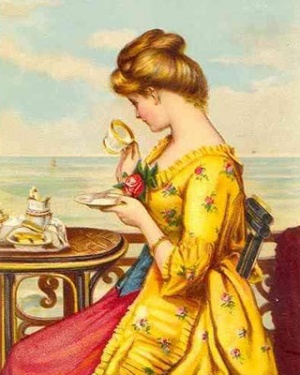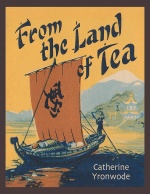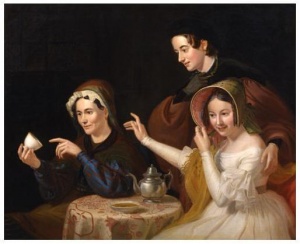Viewing the Cup
From Mystic Tea Room
(edit and save) |
|||
| Line 56: | Line 56: | ||
==Sharing the Gaze With a Family Member, Friend, or Client== | ==Sharing the Gaze With a Family Member, Friend, or Client== | ||
| + | |||
| + | [[File:Nicholas-Joseph-Crowley-1813-1857-Fortune-Telling-by-Cup-Tossing.jpg|right|thumb|300px|"Cup Tossing," also known as "Fortune Telling by Cup Tossing," oil paining the the Irish artist Nicholas Joseph Crowley (1813-1857); the reader, who is on intimate terms with the sitters, uses her finger to point out the images in the cup.]] | ||
If you are reading for a sitter who is emotionally close to you, such as a family member, or if you are showing your own cup to a friend who will in turn be showing hers to you, it is common practice to hold the cup up, sit very close to one another, or have your friend look over your shoulder and ask them if they see the image. | If you are reading for a sitter who is emotionally close to you, such as a family member, or if you are showing your own cup to a friend who will in turn be showing hers to you, it is common practice to hold the cup up, sit very close to one another, or have your friend look over your shoulder and ask them if they see the image. | ||
| Line 63: | Line 65: | ||
When reading tea cups professionally, you should never get into a game of "Do you see what i see?" with the sitter. YOU, after all, are the reader; the sitter has come to you for answers, not for a play-party. Tell the client what you see and interpret it. | When reading tea cups professionally, you should never get into a game of "Do you see what i see?" with the sitter. YOU, after all, are the reader; the sitter has come to you for answers, not for a play-party. Tell the client what you see and interpret it. | ||
| - | + | In "Cup Tossing," a 19th century genre painting by Nicholas Joseph Crowley, we see this familial intimacy as an old woman points out the symbols in the cup to a young woman who snuggles in under her arm and touches her trustingly. Notice the physical resemblance between the two women. It is easy to imagine that this is a grandmother reading fortunes for her grandchild. Common sense tells us that it is unlikely that a paying customer would hug into her reader so tightly. | |
==Indicating the Image with a Finger== | ==Indicating the Image with a Finger== | ||
| - | [[File: | + | [[File:Dregs-In-The-Cup.jpg|right|thumb|300px|"Dregs in the Cup"; the reader is holding the cup and describing an image, but the client or family member is not looking.]] |
| + | |||
Taking control of the reading can be as simple as pointing out the images with a finger. Now your family member or friend will have to see what you see. | Taking control of the reading can be as simple as pointing out the images with a finger. Now your family member or friend will have to see what you see. | ||
| Line 73: | Line 76: | ||
"I see a squirrel on a branch. See? Here is his tail, all arched up ... and he is holding a nut in his little hands." | "I see a squirrel on a branch. See? Here is his tail, all arched up ... and he is holding a nut in his little hands." | ||
| - | Your verbal description and the use of a guiding finger, makes the image clear | + | Your verbal description and the use of a guiding finger, makes the image clear. |
| - | + | ||
| - | + | ||
| - | + | ||
| - | + | ||
Revision as of 04:54, 15 August 2022
In this installment of "From the Land of Tea," we take a look at a web page that was funded by my Patreon supporters, who had access to it one full year before the public.
- Patreon Release Date: August 14th, 2021
- Public Release Date: August 14th, 2022.
Please consider subscribing to my Patreon stream for as little as $2.00 per week:
Patrons: To discuss this and other Patreon pprojects with me, please join my private Patreon Forum:
Support From the Land of Tea
All of the material you have access to here -- the fabulous tea cups, the instructive booklets, the nostalgic postcards, the boldly graphic matchbook covers, and all of the historical information researched and shared from the mind of the woman who is making it all happen -- can easily fit into one 8 x 10 foot room in an old Victorian farmhouse, but you would never see it without the investment of the time it takes to produce such a site and the caloric input such a site requires in the form of food for the writer, graphic designer, and database manager, as well as the US currency needed to pay for the computers, software applications, scanners, electricity, and internet connectivity that bring it out of that little room and into the world. So, as you can see, this site is the darling of many, and it is growing at a rapid rate ... but although it is "free," there also is a cost. Your financial support underwrites this cost.
Each new web page or sample pdf is circulated to Patrons as an unpublished galley proof or advance copy. After one year access for Patrons, each web page will be released to the public, while book pages will be available to the public as printed books, and copies will be sent to Patrons who subscribe at the upper two tiers.
Patrons have access to a Private Patreon sub-forum within the Lucky Mojo Forum, and will be accorded special Red Star Avatar badges at the Forum.
Viewing the Cup
Although it seems a simple thing to look into the tea cup and see images in the leaves, there are at least three ways to do so. The results may be the same, but the manner of presentation is different. All are traditional and none is "better" than another.
Let us begin with the usual drinking off of the tea, the swirling or swinging of the cup, the inversion and rotation of the cup in the saucer, and the tapping of the bottom. Not every reader does all of these things, but most readers understand the method and follow its general principles. For more complete details, see "The Stranger in the Cup" by Gregory White and Catherine Yronwode.
Next comes the handling of the cup as you look within for the images:
- If you are reading for yourself, hold the cup in your dominant hand and tip it slightly toward you, as if about to take a drink, then consider what images appear.
- If you are reading for a sitter, start by holding the cup the way the sitter did (right handed or left handed) and tipping it toward you as he or she did when taking the last sip from the cup. If you see nothing, rotate the cup slightly, a few degrees at a time, until an image comes into view. Remember, even "non-images" like a row of dots do have a meaning.
- Do not set the cup down until you finish your reading, for if you do, the residual liquid in the cup may cause the images to slide, change, and become disfigured.
All right, having understood what your hands will do during the reading, now we can look at the three major variations in how the reading is performed.
Gazing With Your Eyes Only

When reading a teacup for yourself it is the simplest and most natural thing in the world to simply look into the cup and see pictures among the leaves.
You do not need to touch the leaves or explain to yourself or anyone else what they look like, because your eyes convey the information directly to your brain.
This method, which i call "Gazing" is meditative and quiet. If you want to memorialize such a reading, all you have to do is photograph it at the angle which best displays the images that you see. If you are an artist, you might prefer to draw it. Date your reading so you can refer to it again and annotate the image if it "comes true.
In a way, gazing is so trivial that it seems odd to mention it as a "method." However, when we move on to the next methods, you will understand that it is, in fact, one of several ways to view a cup.
Sharing the Gaze With a Family Member, Friend, or Client
If you are reading for a sitter who is emotionally close to you, such as a family member, or if you are showing your own cup to a friend who will in turn be showing hers to you, it is common practice to hold the cup up, sit very close to one another, or have your friend look over your shoulder and ask them if they see the image.
Asking for the gaze of another person can take the form of a game -- "Do you see the squirrel?" or "I see a squirrel -- what do YOU see?" However, if you pose a question in these ways, you must be prepared for your friend or family member to disagree with you -- to see something else, or to see nothing at all, and perhaps to only grudgingly see what you behold so vividly.
When reading tea cups professionally, you should never get into a game of "Do you see what i see?" with the sitter. YOU, after all, are the reader; the sitter has come to you for answers, not for a play-party. Tell the client what you see and interpret it.
In "Cup Tossing," a 19th century genre painting by Nicholas Joseph Crowley, we see this familial intimacy as an old woman points out the symbols in the cup to a young woman who snuggles in under her arm and touches her trustingly. Notice the physical resemblance between the two women. It is easy to imagine that this is a grandmother reading fortunes for her grandchild. Common sense tells us that it is unlikely that a paying customer would hug into her reader so tightly.
Indicating the Image with a Finger
Taking control of the reading can be as simple as pointing out the images with a finger. Now your family member or friend will have to see what you see.
"I see a squirrel on a branch. See? Here is his tail, all arched up ... and he is holding a nut in his little hands."
Your verbal description and the use of a guiding finger, makes the image clear.







